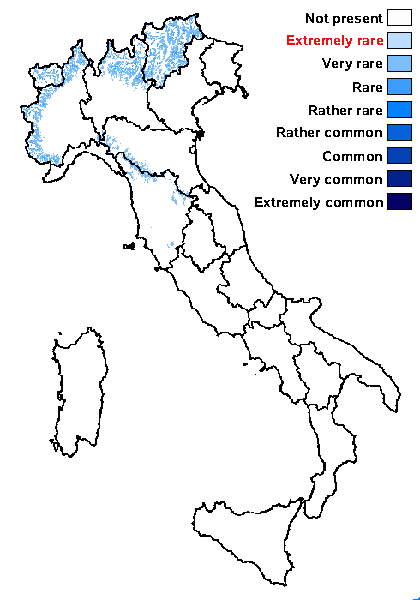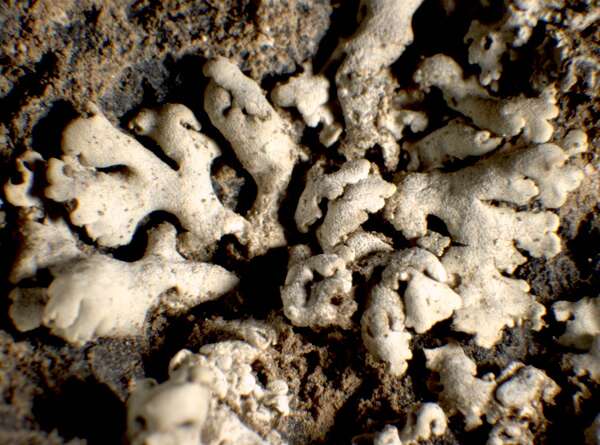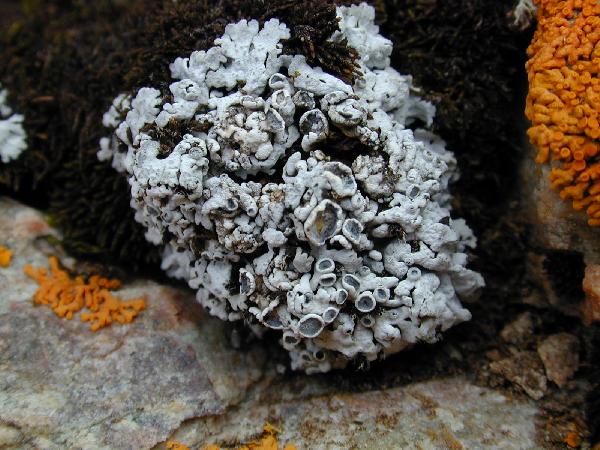Physcia magnussonii Frey
Erg. wiss. Unters. Schweiz. Nationalpark Unterengadin, n. F. 3, 27: 480, 1952.
Synonyms: Physcia aipolia var. subincisa (Th. Fr.) Lynge; Physcia stellaris var. subincisa Th. Fr.
Distribution: N - TAA, Lomb (Favero-Longo & al. 2023), Piem (TSB 34161), VA (Piervittori & Isocrono 1997, 1999, Piervittori & al. 2001, Isocrono & al. 2008), Emil (Fariselli & al. 2020). C - Tosc (Giordani & al. 2009).
Description: Thallus foliose, heteromerous, dorsiventral, narrow-lobed, closely adpressed, forming orbicular, up to 8 cm wide rosettes. Lobes to 3 mm wide, usually overlapping, more or less convex, whitish grey to brownish grey, emaculate, distinctly and densely white-pruinose, the margins often down-turned at lobe-tips. Lower surface white to brownish, with a few, stout, simple rhizines. Upper cortex paraplectenchymatous; medulla white. Apothecia common, lecanorine, to 3 mm across, with a usually white-pruinose, otherwise black disc and a smooth thalline margin. Epithecium brown; hymenium and hypothecium colourless; paraphyses slender, simple or forked in upper part, the apical cells clavate, with a thin, dark brown cap. Asci 8-spored, clavate, the K/I+ blue tholus penetrated by a faintly amyloid apical cushion with parallel or diverging flanks, the wall K/I-, surrounded by a K/I+ blue outer layer, Lecanora-type. Ascospores 1-septate, brown, narrowly ellipsoid, 16-24 x 6-9 µm, the wall with a distinct verrucose ornamentation, thickened at apex and at septum, Physcia-type. Pycnidia common, immersed, black. Conidia subcylindrical. Photobiont chlorococcoid. Spot tests: upper cortex K+ yellow, C-, KC-, P- or P+ faintly yellow; medulla K- or K+ pale pink, C-, KC-, P-. Chemistry: upper cortex with atranorin; medulla with accessory zeorin and/or variolaric acid.
Note: on steeply inclined surfaces of base-rich siliceous rocks, often starting its development in fissures of the rock; for Italy hitherto known only from the Alps and the northern Apennines, but is likely to be found on some Mediterranean mountains with suitable substrata.
Growth form: Foliose, narrow lobed
Substrata: rocks
Photobiont: green algae other than Trentepohlia
Reproductive strategy: mainly sexual
On otherwise dry surfaces with short periods of water seepage after rain
Commonnes-rarity: (info)
Alpine belt: absent
Subalpine belt: rare
Oromediterranean belt: absent
Montane belt: very rare
Submediterranean belt: absent
Padanian area: absent
Humid submediterranean belt: absent
Humid mediterranean belt: absent
Dry mediterranean belt: absent

Predictive model
Herbarium samples
Growth form: Foliose, narrow lobed
Substrata: rocks
Photobiont: green algae other than Trentepohlia
Reproductive strategy: mainly sexual
On otherwise dry surfaces with short periods of water seepage after rain
Commonnes-rarity: (info)
Alpine belt: absent
Subalpine belt: rare
Oromediterranean belt: absent
Montane belt: very rare
Submediterranean belt: absent
Padanian area: absent
Humid submediterranean belt: absent
Humid mediterranean belt: absent
Dry mediterranean belt: absent

Predictive model
| Herbarium samples |
 INDEX FUNGORUM
INDEX FUNGORUM
 GBIF
GBIF
 DOLICHENS
DOLICHENS




